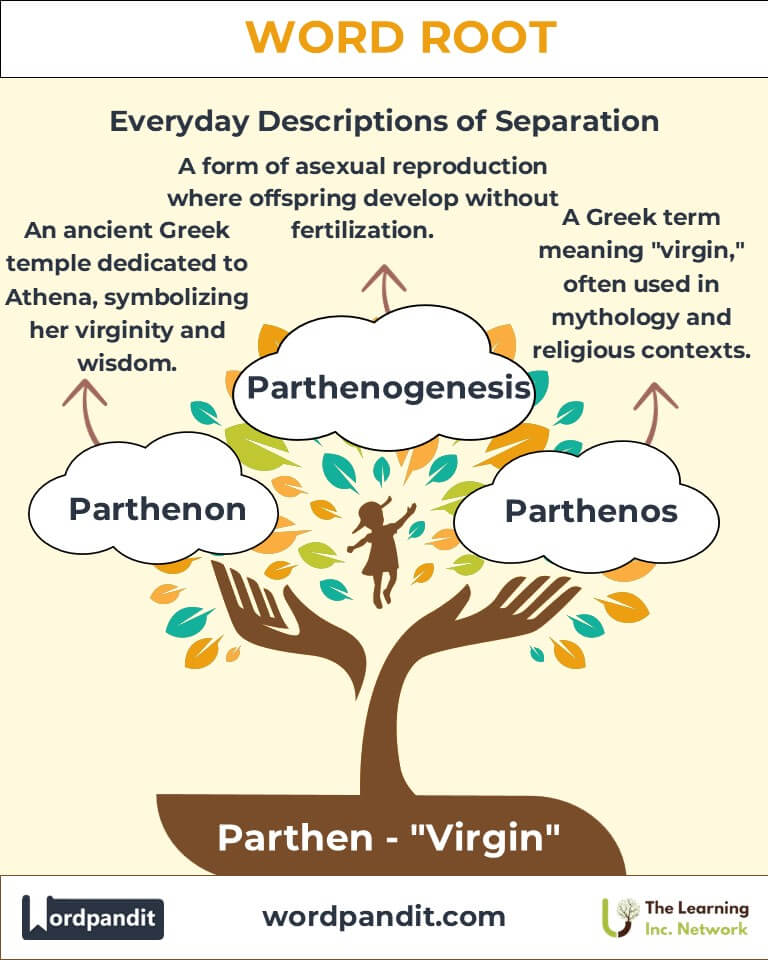Parthen: The Root of Purity and Creation
Discover the fascinating world of the root "parthen," derived from the Greek word for "virgin." From ancient temples to modern science, this root speaks to ideas of purity, untouched creation, and miraculous phenomena. Learn how it has shaped language, culture, and specialized fields like biology.

Table of Contents
- Introduction: The Essence of "Parthen"
- Etymology and Historical Journey
- Mnemonic: Unlocking the Power of "Parthen"
- Common Parthen-Related Terms
- Parthen Through Time
- Parthen in Specialized Fields
- Illustrative Story: Parthen in Action
- Cultural Significance of the Parthen Root
- The Parthen Family Tree
- The Parthen Faqs
- Test Your Knowledge: Parthan Mastery Quiz
- Conclusion: The Living Legacy of "Parthen"
Introduction: The Essence of "Parthen"
The root parthen (pronounced PAR-then) originates from the Greek word parthenos, meaning "virgin." It evokes images of purity and untouched origins, resonating in words like parthenogenesis and Parthenon. Across fields from mythology to science, "parthen" has represented the marvel of creation without prior influence. Whether in ancient Greece or modern biology, this root symbolizes unique beginnings and untapped potential.

Etymology and Historical Journey
The word parthenos played a prominent role in ancient Greek culture. It signified virginity not just in the physical sense but also metaphorically, symbolizing something pure, unspoiled, and independent.
- In mythology: Athena, the virgin goddess of wisdom, was associated with the Parthenon, the famed temple in Athens dedicated to her.
- In science: Over centuries, the root extended its reach to biology, where parthenogenesis describes reproduction without fertilization.
This journey underscores the word's enduring connection to extraordinary origins and sacred purity.
Mnemonic: Unlocking the Power of "Parthen"
To remember the meaning of parthen, imagine a snow-covered mountain untouched by footsteps—a perfect symbol of purity and new beginnings.
Mnemonic Device: “Parthen preserves purity, whether in temples or miraculous births.”
Common Parthen-Related Terms
- Parthenogenesis (par-then-oh-JEN-uh-sis): A form of asexual reproduction where offspring develop without fertilization.
Example: “Bees can produce male drones through parthenogenesis.” - Parthenon (PAR-theh-non): The ancient Greek temple dedicated to Athena, symbolizing her virginity and wisdom.
Example: “The Parthenon stands as a masterpiece of classical architecture.” - Parthenocarpy (par-then-oh-KAR-pee): The development of fruit without fertilization.
Example: “Parthenocarpic fruits like bananas lack seeds.” - Parthenium (PAR-theh-nee-um): A genus of flowering plants, some of which reproduce without pollination.
Example: “Parthenium weeds are common in subtropical regions.”
Parthen Through Time
The root parthen has evolved over centuries, adapting to different fields and contexts:
- Classical Era:
- The Parthenon, built in 447 BCE, celebrated Athena’s purity and the cultural ideals of Athens.
- Modern Biology:
- The term parthenogenesis emerged in the 19th century, revolutionizing our understanding of reproduction.
- Agriculture:
- Advances in plant breeding introduced parthenocarpy to produce seedless crops like cucumbers and grapes.
Parthen in Specialized Fields
The influence of parthen extends into various disciplines:
- Biology: Parthenogenesis enables certain animals, such as lizards and insects, to reproduce asexually, contributing to our understanding of genetics and evolution.
- Architecture and History: The Parthenon remains a symbol of perfection and dedication to ideals.
- Agriculture: Parthenocarpic fruits have become essential in commercial farming, offering seedless varieties preferred by consumers.
- Medicine: Research into parthenogenesis holds potential for regenerative medicine and cloning.
Illustrative Story: Parthen in Action
In a remote laboratory, Dr. Elena had a breakthrough. Studying the whiptail lizards of the desert, she observed parthenogenesis in action—females reproducing without males. This discovery offered hope for endangered species, proving that nature could adapt in remarkable ways. Meanwhile, in her personal life, Elena admired the Parthenon as a reminder of resilience and ingenuity, drawing inspiration from both ancient and modern expressions of parthen.
Cultural Significance of the Parthen Root
The parthen root has profound cultural implications:
- Mythology and Religion: The virginity of Athena linked parthenos to wisdom and purity in Greek culture.
- Symbol of Independence: The Parthenon’s enduring legacy represents not only architectural brilliance but also the strength of an unspoiled idea.
- Modern Science: In biology, parthenogenesis highlights nature’s capacity for miraculous creation.

The Parthen Family Tree
Explore related roots and their meanings:
- Gen (origin, birth):
- Genesis: The origin or beginning of something.
- Genetics: The study of heredity.
- Karpos (fruit):
- Carpology: The study of fruits and seeds.
- Theo (god):
- Theology: The study of religious beliefs.
FAQs About the Parthen Root
Q: What does "parthen" mean?
A: "Parthen" means "virgin" and originates from the Greek word parthenos, symbolizing purity, untouched creation, or something unspoiled. It can refer to literal virginity or metaphorical independence, as seen in terms like Parthenon or parthenogenesis.
Q: What is parthenogenesis?
A: Parthenogenesis is a type of asexual reproduction where an organism produces offspring without fertilization. This occurs naturally in some species like whiptail lizards, bees, and certain sharks. In plants and animals, parthenogenesis demonstrates nature’s ability to create life in extraordinary ways.
Q: Why is the Parthenon significant?
A: The Parthenon is a historic temple in Athens, dedicated to Athena, the virgin goddess of wisdom. Built in the 5th century BCE, it symbolizes ancient Greece’s architectural excellence and reverence for divine purity. It has become an enduring cultural icon representing ideals of perfection and creativity.
Q: What is parthenocarpy?
A: Parthenocarpy is the development of fruits without fertilization, resulting in seedless varieties. Common examples include bananas, seedless grapes, and cucumbers. This process is vital in agriculture, ensuring consistent yields of seedless produce for consumer preferences.
Q: Are there examples of parthenogenesis in nature?
A: Yes, parthenogenesis occurs in various species. Examples include:
- Bees: Male drones arise from unfertilized eggs.
- Lizards: Some whiptail lizards reproduce exclusively through parthenogenesis.
- Sharks: Rarely, sharks in captivity have produced offspring without mating. This phenomenon demonstrates evolutionary adaptation in certain environments.
Q: How does the root "parthen" relate to plants?
A: In plants, "parthen" appears in terms like parthenocarpy, which describes seedless fruit development. It represents a form of asexual reproduction or cultivation, enabling the production of fruits without pollination or fertilization.
Q: Is parthenogenesis used in scientific research?
A: Yes, parthenogenesis is studied in genetics, developmental biology, and cloning. Scientists explore its mechanisms to understand reproduction better and its potential applications in regenerative medicine, including creating stem cells.
Q: Does the Parthenon have any connection to parthenogenesis?
A: Both terms share the root parthenos (virgin), but their contexts differ. The Parthenon symbolizes Athena’s purity, while parthenogenesis describes virgin reproduction in biology. Both evoke themes of unique, untouched creation.
Test Your Knowledge: Parthen Mastery Quiz
1. What does the root "parthen" signify?
2. What is parthenogenesis?
3. Where is the Parthenon located?
4. What does parthenocarpy refer to?
5. Which animal exhibits natural parthenogenesis?

Conclusion: The Living Legacy of "Parthen"
From the grandeur of the Parthenon to the wonders of parthenogenesis, the root parthen encapsulates purity and innovation. It bridges the ancient and modern, showcasing untouched creation and miraculous beginnings.











